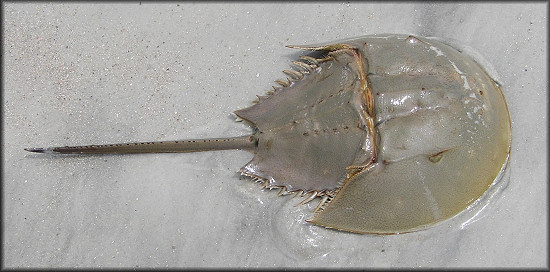|
Limulus polyphemus Atlantic Horseshoe Crab |
| Horseshoe Crabs, both dead and alive, are occasionally found on northeast Florida beaches. However, living juvenile specimens (about 15-30 mm.) can be found by the thousands in certain areas near inlets which are sheltered from the open Atlantic. |
|
|
|
|
|
Live in the surf, Mayport Naval Station Beach, Duval Co., FL 8/18/2005 (about 300 mm. - shell) |
|
The original description of this Horseshoe Crab <http://gdz.sub.uni-goettingen.de/dms/load/img/?PPN=PPN362053006&DMDID=DMDLOG_0043&LOGID=LOG_0043&PHYSID=PHYS_0639>
appeared on p. 634 of the Tenth Edition of Linnaeus' Systema Naturae,
the sentinel work in which formal animal taxonomy was launched. The
author classified it as a wingless insect (Aptera) and in the
subordinate group Cancer, including many crabs. It was the first species
listed in the genus Monoculus.* The species was transferred to the genus Limulus Müller (1785: 124), of which it is the type by exercise of the plenary powers of the International Commission for Zoological Nomenclature two centuries later! Müller unnecessarily renamed the Linnaean species Limulus gigas <http://www.biodiversitylibrary.org/item/50326#page/132/mode/1up>, an objective junior synonym, on the next page. Earlier in this work Müller had restricted the Linnaean Monoculus to certain freshwater copepods. An arthropod, Limulus polyphemus (Linnaeus, 1758) is now placed in subclass Chelicerata and thus is taxonomically remote to the copepods, crabs, and insects. The only member of its genus, it is found only in eastern North American marine waters. Its family, Limulidae, with just four Recent species, is the only surviving lineage of Horseshoe Crabs (Order Xiphosura), which animals have been on our planet since the Triassic Era, over 200,000,000 years ago.
*Monoculus
telemus, the ninth congener, is described on
the next page. This species is now recognized as a pteropod mollusk (sea
butterfly) and is the type species of Cavolina Abildgaard, 1791
[spelling emended to Cavolinia in Opinion 883 of the
International Commission on Zoological Nomenclature]. Some authorities
consider it a senior synonym of the locally-occurring C.
tridentata (Niebuhr, 1775). Another congener is
Cavolinia uncinata
(Rang, 1829) Uncinate Cavoline. |

